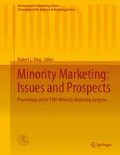Abstract
The purpose of this paper is to draw an expenditure profile of black consumers and to develop a model to measure the purchasing patterns of blacks. Data from the Bureau of Labor Statistics is analyzed using an income elasticity model based on Engel curves to establish elasticity coefficients for expenditure patterns by blacks.
Access this chapter
Tax calculation will be finalised at checkout
Purchases are for personal use only
Preview
Unable to display preview. Download preview PDF.
References
Ackley, Gardner (1961), Macroeconomic Theory, New York: The Macmillan Company.
Askin, Steve (1983), "The Hidden Power of Pension Funds," Black Enterprise 13 (January), PP 35–37.
Brennan, Michael J. (1965), Theory of Economic Statics, Englewood Cliffs, N. J.: Prentice-Hall, Inc.
Dingle, Derek T. (1986), "Seeking An Agenda for Economic Growth," Black Enterprise, 16 (June), pp. 201–208.
Duesenberry, J. S. (1949), Income, Saving and the Theory of Consumer Behavior, Boston: Harvard University Press.
Fareed, F. E. and G. D. Riggs (1982), "Old-Young Differences in Consumer Expenditure Patterns," The Journal of Consumer Affairs, 16 (Summer), 152–160.
Ferguson, C. E. and J. P. Gould (1975) Microeconomic Theory, Homewood, IL: Richard D. Irwin, Inc.
Fitch, Ed. (1986), "Agencies Playing For Equality From Advertisers," Advertising Age, 57 (August 25) pp. 15–30, 31.
Graves, Earl G. (1985), "Recognizing Our Value As Consumers," Black Enterprise, 16 (December), p. 9.
Hrumnermesh, Daniels. (1986), "Consumption During Retirement: The Missing Link in the Life Cycle," Review of Economics and Statistics, 66 (February), pp. 1–7.
Henderson, James M. and Richard F. Quandt (1980) Microeconomic Theory: A Mathematical Approach, New York: McGraw-Hill Book Company.
Joseph, Franklyn W. (1986), "Despite Growth In Market, Strong Resistance Continues," Advertising Age, 57 (August 25), pp. 5–1, 5-2.
Lewis, Sir Arthur (1983), "Black Americans And The Changing World Economy," Black Enterprise, 13 (March), pp. 36, 39.
Maggard, John P. (1971), "Negro Market-Fact or Fiction," California Management Review, 14 (Fall), pp. 71–80.
Management Review, (1986), "Debunking Iltlmic Marketing Myths," 75 (April), pp. 5–6.
Mansfield, Edwin (1979), Microeconomics, New York: W. W. Norton.
Marketing & Media Decisions, (1984), "A Segmentation Approach To The Market," 19 (May), pp. 131–136.
Martin, Joel P. (1984), "Segmenting the Black Market," Marketing Communication, 10 (July), 17–19, p. 69.
Maurice, S. Charles and Owen R. Phillips (1986), Economic Analysis: Theory and Application, Homewood, IL: Irwin.
McNatt, Robert (1984), "Black America In a State of Crisis, "Black Enterprise, 14 (January), pp.28–32, 34, 36–39.
Millican, Richard D. (1967) "A Re-examination of Engel’s Laws Using BLS Data (1960–61)," Journal of Marketing, 31 (October), 18–21.
O’Hare, William (1987), "Black and Whites: One Market or Two?," American Demographics, 9 (March) pp. 44–48.
Paskowski, Marianne (1986), "Shades of Grey," Marketing & Media Decisions, 21 (March), pp. 30–32, 34, 38, 40.
Swisshelm, George (1986), "Black Income Expected to Surpass $204 Billion in ’86," Television/Radio Age, 33 (February 17), pp. A3-A4, A6-A8.
U. S. Department of Labor, Bureau of Labor Statistics (1974) Consumer Expenditure Survey Series: Interview Survey, 1972 and 1973, Report 455–3.
—(1985), Consumer Attitude Survey: Interview Survey, 1980–81, Bulletin 2225.
—(1986a), Consumer Attitude Survey: Interview Survey, 1982–83, Bulletin 2246.
—(1986b), Consumer Attitude Survey:Interview Survey, 1984, Bulletin 2267.
Wright, Carroll D. (1875), Sixth Annual Report of the Bureau of Statistics and Labor, Boston: State Printers.
Author information
Authors and Affiliations
Editor information
Editors and Affiliations
Rights and permissions
Copyright information
© 2015 Academy of Marketing Science
About this paper
Cite this paper
Linhardt, W.C. (2015). Determining Black Expenditure Patterns Using Elasticity Coefficients: Developing a Profile. In: King, R. (eds) Minority Marketing: Issues and Prospects. Developments in Marketing Science: Proceedings of the Academy of Marketing Science. Springer, Cham. https://doi.org/10.1007/978-3-319-17392-4_5
Download citation
DOI: https://doi.org/10.1007/978-3-319-17392-4_5
Publisher Name: Springer, Cham
Print ISBN: 978-3-319-17391-7
Online ISBN: 978-3-319-17392-4
eBook Packages: Business and EconomicsBusiness and Management (R0)

